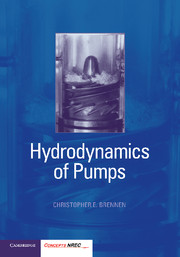Book contents
- Frontmatter
- Contents
- Preface
- Nomenclature
- 1 Introduction
- 2 Basic Principles
- 3 Two-Dimensional Performance Analysis
- 4 Other Flow Features
- 5 Cavitation Parameters and Inception
- 6 Bubble Dynamics, Damage and Noise
- 7 Cavitation and Pump Performance
- 8 Pump Vibration
- 9 Unsteady Flow in Hydraulic Systems
- 10 Radial and Rotordynamic Forces
- Bibliography
- Index
8 - Pump Vibration
Published online by Cambridge University Press: 04 February 2011
- Frontmatter
- Contents
- Preface
- Nomenclature
- 1 Introduction
- 2 Basic Principles
- 3 Two-Dimensional Performance Analysis
- 4 Other Flow Features
- 5 Cavitation Parameters and Inception
- 6 Bubble Dynamics, Damage and Noise
- 7 Cavitation and Pump Performance
- 8 Pump Vibration
- 9 Unsteady Flow in Hydraulic Systems
- 10 Radial and Rotordynamic Forces
- Bibliography
- Index
Summary
Introduction
The trend toward higher speed, high power density liquid turbomachinery has inevitably increased the potential for fluid/structure interaction problems, and the severity of those problems. Even in the absence of cavitation and its complications, these fluid structure interaction phenomena can lead to increased wear and, under the worst conditions, to structural failure. Exemplifying this trend, the Electrical Power Research Institute (Makay and Szamody 1978) has recognized that the occurrence of these problems in boiler feed pumps has contributed significantly to downtime in conventional power plants.
Unlike the cavitation issues, unsteady flow problems in liquid turbomachines do not have a long history of research. In some ways this is ironic since, as pointed out by Ek (1957) and Dean (1959), the flow within a turbomachine must necessarily be unsteady if work is to be done on or by the fluid. Yet many of the classical texts on pumps or turbines barely make mention of unsteady flow phenomena or of design considerations that might avoid such problems. In contrast to liquid turbomachinery, the literature on unsteady flow problems in gas turbomachinery is considerably more extensive, and there are a number of review papers that provide a good survey of the subject (for example, McCroskey 1977, Cumpsty 1977, Mikolajczak et al. 1975, Platzer 1978, Greitzer 1981). We will not attempt a review of this literature but we will try, where appropriate, to indicate areas of useful cross-reference.
- Type
- Chapter
- Information
- Hydrodynamics of Pumps , pp. 137 - 171Publisher: Cambridge University PressPrint publication year: 2011
- 2
- Cited by



